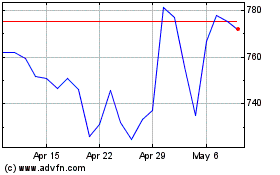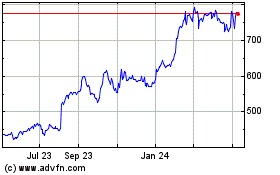By Lauren Weber
Drugmakers have hits and misses when it comes to medicines, with
some becoming blockbusters and others producing results so minimal
they barely register in clinical trials.
The same can happen with internal initiatives -- at least
according to Eli Lilly & Co.
A few years ago, the Indianapolis-based pharmaceutical firm
realized that its diversity efforts were yielding little progress
in terms of closing leadership gaps for women and people of color.
The improvements were so meager that Lilly executives estimated it
would take 70 years for the share of women in the company's top
positions to match that of men.
So Lilly, the maker of medicines such as Prozac, Cialis and
Trulicity, decided to try a new approach: It turned to a process
its brand-development teams use to better understand what patients
experience when they are ill, and used that process to get a
clearer picture of the barriers to advancement faced by the women
and people of color it employs.
The "Patient Journey," as Lilly calls the series of surveys,
focus groups and online journaling it asks patients to complete,
became the "Employee Journey." Around 400 women in management
identified as having high potential went through the process, which
began in 2015.
It worked because it took a business process that already had
credibility within the firm and applied it to the often-ambiguous
work of diversity, says Joy Fitzgerald, who became vice president
of diversity and inclusion shortly after the effort began. "That's
like the nirvana of D&I," she says.
The exercise revealed that the opportunities for advancement
Lilly had been presenting to women didn't work for everyone. In
particular, women of color were experiencing some different
challenges than their white counterparts. The feedback that
resulted sparked changes in the company's culture and processes
that have significantly boosted the representation of women and
people of color in Lilly's leadership ranks.
Lack of understanding
From December 2016 to August 2019, the share of women in
management grew to 44% from 38%, and the share of women who report
directly to the CEO rose to 38% from 29%, Lilly says. Women of
color now make up 9% of vice presidents and senior vice presidents
in the U.S., up from 3% in 2016.
The changes Lilly made included altering its recruitment,
development and succession processes based on corporate best
practices, putting measurements in place that are monitored
quarterly and reported to the workforce, and reviewing talent
metrics with all top leaders at least once a year.
Lilly's progress stands out compared with the broader
pharmaceutical and medical-product sector. Women occupy 24% of
senior-vice-president roles and 25% of C-suite jobs in the
industry, according to McKinsey & Co. and LeanIn.Org, which
analyzed data from 21 companies. Women of color account for 4% of
senior V.P.s and 5% of C-suite executives industrywide, while white
men and men of color occupy 63% and 12% of those two positions,
respectively.
Diversity work is "complex, emotional, controversial and tense,"
Ms. Fitzgerald says, adding that "the underpinning of being
vulnerable is that people think you're being a victim, and no one
wants to be a victim, particularly at work."
At Lilly, a Midwestern company founded in 1876 by a Civil War
veteran, politeness is valued, employees say. "we have a very kind
and nice and well-intended culture," says Laurie Kowalevsky, a
marketing executive who spearheaded the journey experiment. "But
there was a lack of understanding about what some of those
experiences were."
The results of the first journey exercise were presented at a
retreat for the executive committee in French Lick, Ind., in
February 2016. Leaders read survey data and anonymized journal
entries and listened to recordings of women describing their
careers at Lilly, including experiences of being overlooked or
having a sense of not belonging.
The stories challenged assumptions held by many at Lilly,
including its chief executive, Dave Ricks.
"I'm married to a working woman, I've got a daughter, I'm the
son of a working woman. I thought the things that happened to women
I loved and knew would not happen in my company," he said in March
of this year, when Lilly was honored with an award for its
diversity work from Catalyst, an organization focused on empowering
women in the workplace. "But they happened."
Looking at data "isn't the same as hearing the voices," adds
Steve Frey, Lilly's head of human resources and diversity. The
company shared the results with the entire workforce.
The results also led to a troubling realization by the team that
had organized the process. By focusing on women in fairly senior
roles, it had failed to get a critical mass of voices of women of
color, leading to an incomplete picture of women's experiences at
Lilly.
"The gap was pointing to the problem," says Ms. Kowalevsky. "The
representation of African-American women in the pipeline wasn't
where you would want it to be."
Standing ovation
Shortly after, Lilly went through the employee journey process
with African-American, Asian and Latino employees specifically. As
in the first exercise, employees were asked to participate in focus
groups and take extensive surveys.
Among them was Shannon Alston Rush, currently head of Lilly's
diabetes business in the U.K., Ireland and the Nordic countries.
Ms. Rush now chairs Lilly's women's resource group, called Women's
Initiative for Leading at Lilly, which has around 2,000 members.
When Ms. Rush became the group's leader, she introduced herself by
describing many of her experiences at the company at a meeting
attended by more than 1,000 employees.
"It took me weeks to unravel my 20 years here," she says. During
her 40-minute presentation, Ms. Rush talked about how it felt to be
the only African-American woman in a room at many times during her
career, "to be in the room where you're leading the
[profit-and-loss statement] yet no one is asking you the
questions." Afterward, she received a standing ovation.
Mr. Ricks has conducted two leadership programs, called Emerge,
for senior managers. The first engaged about 15 African-American
women; the second was for 28 Latino and Asian women. The programs
were a combination of relationship-building and leadership
development, with Mr. Ricks teaching case studies based on
decisions he has faced in his career.
"It was important to be recognized like that, without asking,
'How do I get on that list?' " says Ms. Rush, who participated in
the first session. "It meant a lot that our CEO took three days off
his calendar" for the program.
Some problems can be addressed by "waving your CEO wand," giving
orders and getting results, Mr. Ricks said at the Catalyst
ceremony. Other problems, he said, can't be fixed that way. For
those, "you have to make things important, and one of the primary
ways leaders can do that, especially the CEO, is by paying
attention to them."
Ms. Fitzgerald believes that commitment is filtering through the
organization, sometimes in unexpected ways. Every year, Lilly hosts
an African-American forum focused on career development and other
issues. In prior years, the event mostly drew African-American
employees. When registration opened this year, the 1,200 available
spots plus the wait list filled up within two hours, and the
majority of participants were Caucasian, she says, suggesting that
interest is broader and stronger than before.
Lilly employees also have begun to share a vocabulary that helps
them have conversations about what might once have been awkward
topics, executives say. "I've been in the room where a man said to
someone, 'Did you just mansplain that to her?' " says Ms.
Kowalevsky. "People now feel more comfortable than not saying those
things."
The company is looking ahead, resetting goals, and already has
begun a journey process for LGBTQ employees. "We've made a lot of
progress in the last five years or so," says Mr. Frey. "We're not
where we want to be still."
Ms. Weber is a Wall Street Journal reporter in New York. Email
her at lauren.weber@wsj.com.
(END) Dow Jones Newswires
October 15, 2019 00:17 ET (04:17 GMT)
Copyright (c) 2019 Dow Jones & Company, Inc.
Eli Lilly (NYSE:LLY)
Historical Stock Chart
From Mar 2024 to Apr 2024

Eli Lilly (NYSE:LLY)
Historical Stock Chart
From Apr 2023 to Apr 2024
